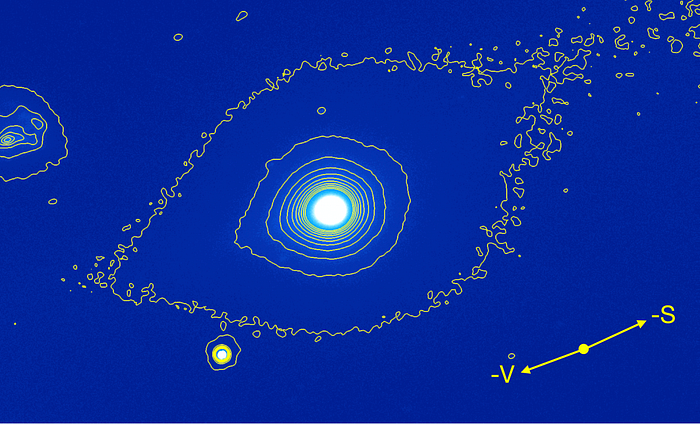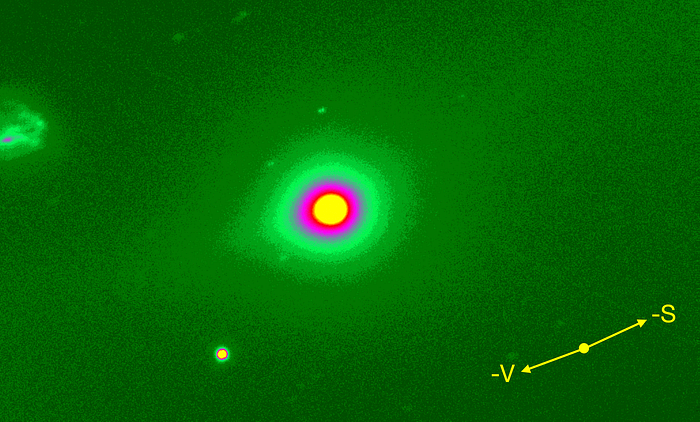Avi Loeb




Breaking News: The interstellar object 3I/ATLAS did not break up near the Sun.
Images taken of 3I/ATLAS on November 11, 2025 show a single body, with no evidence for breakup following the perihelion passage two weeks earlier. The images, reported here, were taken by David Jewitt and Jane Luu on the Nordic Optical Telescope with a primary mirror of 2.56-meter diameter, located at La Palma in the Canary Islands.
The prominent elongation in the glow surrounding 3I/ATLAS projects to a position angle of 106 (+/-10) degrees. This is close to the projected sunward direction of 115 degrees. It resembles the image obtained by the Hubble Space Telescope on July 21, 2025, which showed an anti-tail pointing towards the Sun (as reported here and analyzed here). The new image also shows a weaker asymmetry at a position angle of 301 (+/-1) degrees, which is close to the projected anti-solar direction of 295 degrees.
In units of the Earth-Sun separation (astronomical units=au), the distances of 3I/ATLAS from the Sun and Earth were 1.43 au and 2.16 au, respectively. The imaged region is approximately half a million kilometers wide.
The long-range jet structures evident in recent wide-field pictures taken in recent days (see here and here) are not evident in this data, probably because it was taken through an R-band filter that excluded most of the gaseous emission lines.
Given the large-scale jets reported recently, the fact that 3I/ATLAS remains a single body is surprising for a natural comet. In particular, the large-scale image of 3I/ATLAS reported here on November 9, 2025 shows jets reaching out to ~1 million kilometers towards the Sun and ~3 million kilometers in the opposite direction, as discussed here. For a natural comet, the outflow velocity of the jets is expected to be 0.4 kilometers per second, of order the sound speed of gas at the distance of 3I/ATLAS from the Sun. At that speed, the jets must have persisted over a timescale of 1–3 months.
Given that the jets towards the Sun were stopped by the solar wind at a distance of a million kilometers, I calculated here that their mass density is a few million proton masses per cubic centimeter at a distance of a million kilometers from 3I/ATLAS. The product of this mass density and the outflow speed, implies a mass flux of 5 billion tons per month per area of a million-kilometer on a side.
The sublimation of carbon dioxide (CO2) ice requires an energy of 600 Joules per gram. In order to sublimate ~5 billion tons of CO2 over the perihelion passage period of a month, 3I/ATLAS must have received at least 3×10^{18} Joules. At its perihelion distance, the Sun provided 700 Joules per square meter per second, requiring an absorbing area larger than 1,600 square kilometers. This is the area of a sphere with a diameter of 23 kilometers, 4 times larger than the maximum diameter of 5.6 kilometers inferred for 3I/ATLAS from the imaging data of the Hubble Space telescope reported here. The required diameter is 51 kilometers for water ice. On natural cometary nuclei, the pockets of ice often cover a small fraction of the total surface, making the above numbers untenable for 3I/ATLAS as a single body that maintained its integrity and did not break up into numerous fragments.
This raises a new anomaly of 3I/ATLAS that must be explained by those who wish to shove the anomalies of 3I/ATLAS under the carpet of traditional knowledge on solar system comets rather than consider alternatives. As Albert Einstein said: “Knowledge is realizing that the street is one way; wisdom is looking in both directions anyway.”
Technological thrusters which point their exhaust towards the Sun would accelerate away from the Sun. This post-perihelion maneuver might be employed by a spacecraft that aims to gain speed rather than slow down through the gravitational assist from the Sun.
